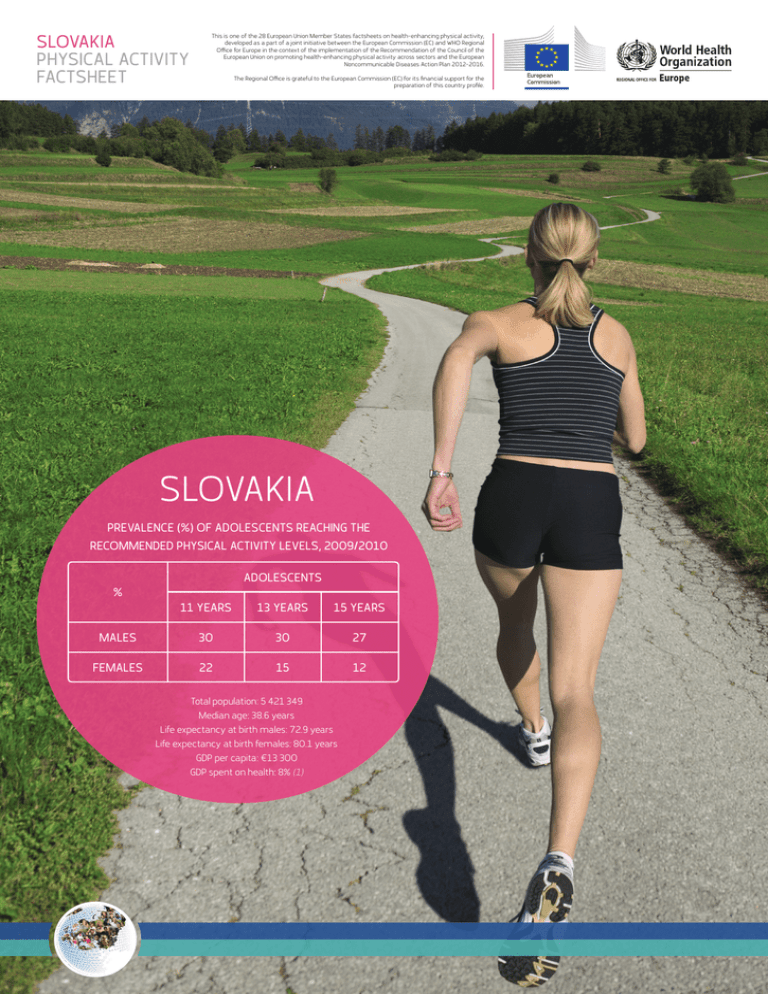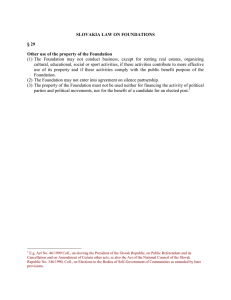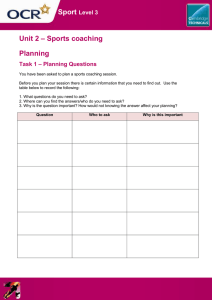Slovakia - Physical Activity Factsheet
advertisement

SLOVAKIA PHYSICAL ACTIVITY FACTSHEET This is one of the 28 European Union Member States factsheets on health-enhancing physical activity, developed as a part of a joint initiative between the European Commission (EC) and WHO Regional Office for Europe in the context of the implementation of the Recommendation of the Council of the European Union on promoting health-enhancing physical activity across sectors and the European Noncommunicable Diseases Action Plan 2012-2016. The Regional Office is grateful to the European Commission (EC) for its financial support for the preparation of this country profile. SLOVAKIA PREVALENCE (%) OF ADOLESCENTS REACHING THE RECOMMENDED PHYSICAL ACTIVITY LEVELS, 2009/2010 ADOLESCENTS % 11 YEARS 13 YEARS 15 YEARS MALES 30 30 27 FEMALES 22 15 12 Total population: 5 421 349 Median age: 38.6 years Life expectancy at birth males: 72.9 years Life expectancy at birth females: 80.1 years GDP per capita: €13 300 GDP spent on health: 8% (1) Monitoring and surveillance Physical activity in adults Slovakia does not currently have a health monitoring and surveillance system that includes population-based measurements of physical activity among adults. Neither does the country have national recommendations on physical activity. According to a Eurobarometer study from 2014 (2), 17% of adults reported that they engage in vigorous-intensity physical activity on at least 4 of the last 7 days, with 83% of those exercising for more than 30 minutes each time. Moreover, 19% of adults reported that they carried out moderate-intensity physical activity on at least 4 of the last 7 days, with 73% of those exercising for more than 30 minutes each time. WHO Global Health Observatory (GHO) data from 2010 for the Slovak adult population (aged 18+ years) (3) show that 80.8% meet WHO’s Global Recommendations on Physical Activity for Health (2010) (4), with males being more likely (83.2%) to meet the recommended physical activity levels than females (78.6%). Physical activity in children and adolescents Physical activity levels in Slovak adolescents are measured through the Health Behaviour in School-aged Children (HBSC) study. According to the 2009/2010 HBSC study (5), adolescent boys (aged 11—15 years) are significantly more active than girls of the same age group. In particular, girls are less likely to participate in physical activity as they grow older. In girls, the highest levels of physical activity were found among those aged 11 years (22.0%) and in boys, among those aged 11 and 13 years (both 30.0%) (see Table 1). Table 1: Prevalence (%) of adolescents reaching the recommended physical activity levels, 2009/2010 ADOLESCENTS % 11 YEARS 13 YEARS 15 YEARS MALES 30 30 27 FEMALES 22 15 12 Source: Currie et al., 2012 (5). The WHO GHO 2010 estimates for Slovak adolescents (defined as aged 11—17 years in relation to WHO data) show that 22.6% meet the WHO recommended physical activity levels for health. The proportion of physical activity at the recommended level is higher in boys than in girls (27.1% versus 18.4%). 2 Slovakia Policy response Major policy documents adopted by government bodies The Slovakian Ministry of Education, Science, Research and Sports adopted the National Sports Strategy in 2012, which emerged from a strategic document on Slovak sports until 2020 (6). This includes provisions for strengthening elite, competitive sports, improving the sports and health field in general, and focusing on children and youth school sports. The National Strategy for the Development of Cycling Transport and Cycle Touring in the Slovak Republic (7) was created in 2013 by the Ministry of Transport, Construction, and Regional Development. It focuses on issues such as transport, sports, safety and urban planning, with a particular focus on improving cycling infrastructure nationwide. According to Act No. 1/2014 on Organising Public Sports Events, the Ministry of Education, Science, Research and Sports annually opens funding calls under the project “Health and Sports” (8). The projects supported by these funds are primarily aimed at organizing health-enhancing physical activity (HEPA) and sporting activities for children and youth, to encourage them to be active in their spare time. In 2014, 23 projects were supported financially by these grants (of up to €250 000). Guidelines and goals Slovakia has not yet finalized any recommendations on physical activity. Table 2 presents a summary of the key measures in place to monitor and address physical activity in the country. Table 2. Summary of key physical activity initiatives in Slovakia HEALTH SPORTS EDUCATION TRANSPORT MONITORING GUIDELINES Counselling on physical activity as part of primary health care services Existence of a national Sports for All policy(ies) Mandatory physical activity in primary and secondary schools National or subnational schemes promoting active travel to school and/or workplace Physical activity included in the national health monitoring system or separate routine survey Existence of a national recommendation on physical activity YES NO YES YES NO NO Additional information on action in key areas Physical activity and sports in schools It is mandatory for primary schools to provide 8 hours per week of physical education (PE) for children. In secondary schools, PE and sports are taught for 10 hours per week. PE and sports are subject to the state educational guidelines established by a department of the Ministry of Education, Science, Research and Sport that is responsible for “health and motion” (9, 10). The guidelines are designed with a focus on lifelong physical activity for health. The key aim is to promote regular physical activity as an important basis for a healthy lifestyle. Slovakia 3 Coordinating body In line with the European Council Recommendation on promoting HEPA across sectors (2013) (11) the Public Health Authority of the Slovak Republic was appointed as a focal point in Slovakia and is therefore entrusted with monitoring physical activity at national level for the general public and facilitating cross-sectoral cooperation. The Public Health Authority is also part of the European Union Physical Activity Focal Points Network. Physical activity counselling and advice Since 2007 the Public Health Authority provides counselling services to promote HEPA and advise on physical activity matters, nationwide (12). Successful approaches “Challenge your heart to motion” campaign This internationally coordinated campaign in Slovakia aims to increase physical activity among the adult population. By means of competition, it encourages the population to include at least 30 minutes of physical activity into their daily leisure time and to lead healthier lives. The challenge is to improve health status and reduce morbidity and mortality from chronic noncommunicable diseases by being more physically active in order to eliminate one of the most significant risk factors (13). The 6th year of the campaign took place from 23 March to 14 June 2015. The contest is organized by regional public health authorities within the framework of the Countrywide Integrated Noncommunicable Diseases Intervention (CINDI) health monitor programme and with the support of WHO (14). The main sponsor is the Regional Public Health Authority in Banská Bystrica. Over the years, the participants joining this campaign have significantly increased their activity levels; many of them have lost excess weight and most of them began to feel better as a direct result of regular physical activity. The statistical data collected are currently being analysed. 4 Slovakia References 1. Eurostat. Your key to European statistics [online database]. Luxembourg: Statistical Office of the European Union; 2015 (June update) (http://ec.europa.eu/eurostat/data/ database, accessed 3 July 2015). 2. Sport and physical activity report. Special Eurobarometer 412. Brussels: European Commission Directorate-General for Education and Culture; 2014. doi:10.2766/73002. 3. Global status report on noncommunicable diseases 2010. Geneva: World Health Organization; 2011 (http://apps.who. int/iris/bitstream/10665/44579/1/9789240686458_eng. pdf, accessed 18 July 2015). 4. Global Recommendations on Physical Activity for Health. Geneva: World Health Organization; 2010 (http:// whqlibdoc.who.int/publications/2010/9789241599979_ eng.pdf, accessed 15 July 2015). 5. Currie C, Zanotti C, Morgan A, Currie D, de Looze M, Roberts C et al. Health behaviour in school-aged children (HBSC) study. International report from the 2009/2010 survey. Copenhagen: WHO Regional Office for Europe; 2012 (Health Policy for Children and Adolescents, No. 6) (http://www. euro.who.int/__data/assets/pdf_file/0003/163857/ Social-determinants-of-health-and-well-being-amongyoung-people.pdf, accessed 7 July 2015). 6. Koncepcia štátnej politiky v oblasti športu – Slovenský šport 2020 [The concept of state policy in the field of sport – Slovak sport in 2020] [website]. Bratislava: Ministry of Education, Science, Research and Sport; 2012 (http:// www.minedu.sk/koncepcia-statnej-politiky-v-oblastisportu-slovensky-sport-2020/, accessed 13 July 2015). 7. National strategy of development of cycling transport and cycle touring in the Slovak Republic. Bratislava: Ministry of Transport, Construction and Regional Development; 2013 (http://www.central2013.eu/fileadmin/user_upload/ Downloads/outputlib/CMB_3.2.3_National_Strategy_ of_Development_of_Cycling__Transport_and_Cycle_ Touring_in_the_Slovak_Republic.pdf, accessed 13 July 2015). 8. Sport policy [website]. Bratislava: Ministry of Education, Science, Research and Sport; 2014 (http://www.minedu. sk/7422-en/sport-finance/, accessed 13 July 2015). 9. Rámcový učebný plán pre základné školy s vyučovacím jazykom slovenským [Framework curriculum for primary schools]. Bratislava: Slovak National Institute for Education; 2011 (in Slovakian) (http://www.statpedu.sk/sk/Statnyvzdelavaci-program/Statny-vzdelavaci-program-pre-1stupen-zakladnych-skol-ISCED-1/Ramcove-ucebne-plany. alej, accessed 20 August 2015). 10.Rámcové učebné plány pre gymnáziá so štvorročným a osemročným štúdiom s vyučovacím jazykom slovenským [Framework curriculum for secondary schools with four-year and eight-year studies]. Bratislava: Slovak National Institute for Education; 2011 (in Slovakian) (http:// www.statpedu.sk/sk/Statny-vzdelavaci-program/Statnyvzdelavaci-program-pre-gymnaziaISCED-3a/Ramcoveucebne-plany.alej, accessed 19 August 2015). 11. Council recommendation on promoting health-enhancing physical activity across sectors. Brussels: Council of the European Union; 2013 (http://ec.europa.eu/sport/library/ news-documents/hepa_en.pdf, accessed 5 August 2015). 12. Poradenské centrum ochrany a podpory zdravia základné informácie [Advisory centre for protection of health – basic information] [website]. Bratislava: Public Health Authority of the Slovak Republic; 2009 (http:// www.uvzsr.sk/index.php?option=com_content&view=ar ticle&id=216:poradenske-centrum-ochrany-a-podporyzdravia-zakladne-informacie&catid=55:poradenskecentrum-ochrany-a-podpory-zdravia&Itemid=61, accessed 19 August 2015). 13. Onedlho odštartuje celonárodná kampaň Vyzvi srdce k pohybu [Nationwide challenge your heart to motion campaign soon to be launched] [website]. Banksá Bystrica: Regional Public Health Authority of Banksá Bystrica; 2015 (http://www.vzbb.sk/sk/aktuality/spravy/2015/vskp2015. php, accessed 21 August 2015). 14.Integrated chronic disease prevention and control [website]. Geneva: World Health Organization; 2015 (http://www.who.int/chp/about/integrated_cd/en/index5. html, accessed 24 August 2015).

